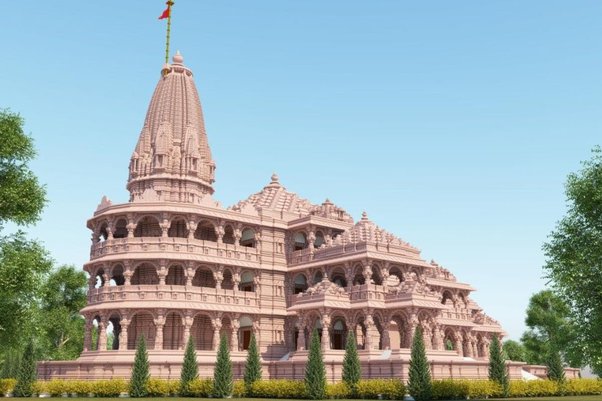In a world where geopolitical dynamics are often shaped by cultural narratives, the Ram Mandir serves as a poignant reminder of Bharat’s commitment to preserving its ancient traditions.
In the heart of Ayodhya, a city steeped in ancient history and religious significance, a monumental transformation is underway—the construction of the Shri Ram Mandir. While the temple holds immense religious and cultural importance for millions of Indians, it is imperative to delve into the diplomatic and geopolitical implications that the Ram Mandir carries for Bharat.
First and foremost, the construction of the Ram Mandir reflects a nuanced understanding of Bharat’s cultural identity and heritage. The temple, dedicated to Lord Ram, a revered figure in Hinduism, symbolizes the continuity of Bharat’s rich cultural tapestry. In a world where geopolitical dynamics are often shaped by cultural narratives, the Ram Mandir serves as a poignant reminder of Bharat’s commitment to preserving its ancient traditions. By embracing and celebrating its cultural roots, Bharat positions itself as a unique player on the global stage, fostering a sense of pride and unity among its citizens.
Moreover, the Ram Mandir can be seen as a strategic move to strengthen Bharat’s soft power. Soft power, a concept popularized by political scientist Joseph Nye, refers to a nation’s ability to influence others through attraction and persuasion rather than coercion. The construction of a grand temple dedicated to Lord Ram is a manifestation of Bharat’s soft power in action. It showcases the country’s cultural richness and diversity, captivating the global audience and creating a positive image that transcends the realms of politics.
In the context of South Asian geopolitics, the Ram Mandir holds the potential to reshape regional dynamics. The construction of the temple could serve as a catalyst for improved relations between Bharat and its neighbours. By demonstrating a commitment to religious pluralism and cultural coexistence, Bharat sends a message of inclusivity to the region. This could foster a more collaborative environment, reducing religious tensions and promoting stability in an often-volatile region. The reemergence of the Global South needs its pegs and symbols. It is not a far stretch to imagine that monuments become to symbols, much like the Vatican, or the Eiffel Tower, or the Statue of Liberty.
The geopolitical significance of the Ram Mandir extends beyond regional boundaries, reaching the global stage. In an era where nations are increasingly conscious of their cultural narratives, the temple becomes a symbol that resonates with people worldwide. It enhances India’s global standing by presenting the country as a guardian of its ancient heritage, contributing to a more diverse and interconnected world.
Furthermore, the Ram Mandir project aligns with Bharat’s aspirations for a leadership role in international affairs. As the world witnesses a shift in power dynamics, with a growing focus on Asia, Bharat seeks to assert itself as a responsible global player. The construction of a grand temple can be viewed as a step towards defining a unique Bharatn identity on the global stage—one that transcends economic and military prowess to embrace cultural and spiritual dimensions.
However, it is crucial to approach the geopolitics of the Ram Mandir with a nuanced perspective. While the project holds promise, it also carries the responsibility of upholding secular values enshrined in Bharat’s Constitution. Striking a balance between celebrating cultural heritage and maintaining a pluralistic society will be essential in navigating the complex intersection of religion and geopolitics.
Finally, geopolitics is about strength. Not just intrinsic or expressed strength, but displayed strength. With the judiciary, government, and civic-society backing Ram Mandir unanimously, India has displayed strength to the world.
To summarize—symbols are important. There is a reason that flags matter, as do crests, and images, and logos. The Ram Mandir stands as a symbol of India’s commitment to its cultural identity, a tool for enhancing soft power, and a potential catalyst for positive regional and global relations. As the temple takes shape, India’s leaders must navigate the geopolitical terrain with sensitivity, ensuring that the project contributes to a more interconnected and harmonious world.
With the Prana Pratishtha at the Ram Mandir, India has finally offered a mix of tangible and intangible heritage to the world, a stepping up of game from the tangible-only (Taj Mahal, Qutub Minar, etc) or intangible-only (yoga, ayurveda, etc) offerings. The Ram Mandir may just become the turning point in the way Indians see ourselves, and indeed, in the way the world sees us.
Anuraag Saxena is a board advisor, public affairs expert, and OpEd columnist. He has been featured in Washington Post, BBC, Vice, The Diplomat, Financial Express, Sunday Guardian, SPAN, etc. He tweets at @anuraag_saxena

